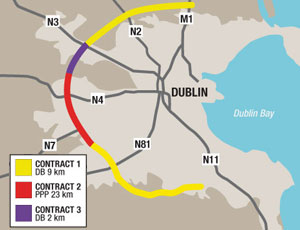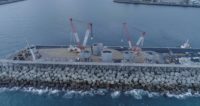...local contractor P. J. Hegarty & Sons has the remaining 15%. Contractual arrangements for the construction of both jobs are similar.
On the Dublin road, the consortium’s special-purpose company, M50 (Concession) Ltd., signed the DBFO contract with NRA in September 2007. The company awarded a fixed-price design-build contract to the construction affiliates of its partners. FCC and Sacyr have 42.5% of the construction joint venture, and Hegarty has the rest.

Starting in February 2008, the consortium is widening the old two-lane roads to three and four lanes over two sections of the M50, totaling some 23 km. Another 11 km has been upgraded by other firms under separate design-build contracts with NRA.
Major interchanges with the M1, N2 and N3 motorways also are being enhanced under the DBFO, along with four smaller ones. Of the job’s 21 elevated sections, the largest is at the N3 interchange.

RICHARD NEULING
As well as widening work, the contract includes making provision for other firms to install traffic management systems. “There’s something like 1,000 km of ducts being put in,” says Atkins’s Neuling.
Atkins is the M50 contractor’s project designer and supervisor. At peak, Atkins had around 150 staff serving the project from offices in several countries, adds Neuling.
All the M50 work is being done while some 100,000 vehicles a day stream through the highway. “The project is about as difficult as it gets,” says Tom O’Malley, Atkins’s managing director in the republic.
Culture Clash
Having started work six months earlier on the $870-million N6 near Galway, the Spanish learned lessons about working with a British-based design team.

OLLALA
A clash of construction cultures on the N6 led the Spanish to include a Madrid-based design firm, Eptisa, in its M50 Atkins-led team, says Francisco Martin de Santa Olalla, FCC’s technical manager on Irish projects.
Based on what he saw on the N6, British designers “are not used to someone from the contractor [on-site] telling them the way it has to be done,” says Martin de Santa Olalla.
“FCC and most Spanish contractors have internal design departments which look after projects. That’s not the case [here],” says Martin de Santa Olalla. “As soon as we get a job, our department goes...



Post a comment to this article
Report Abusive Comment